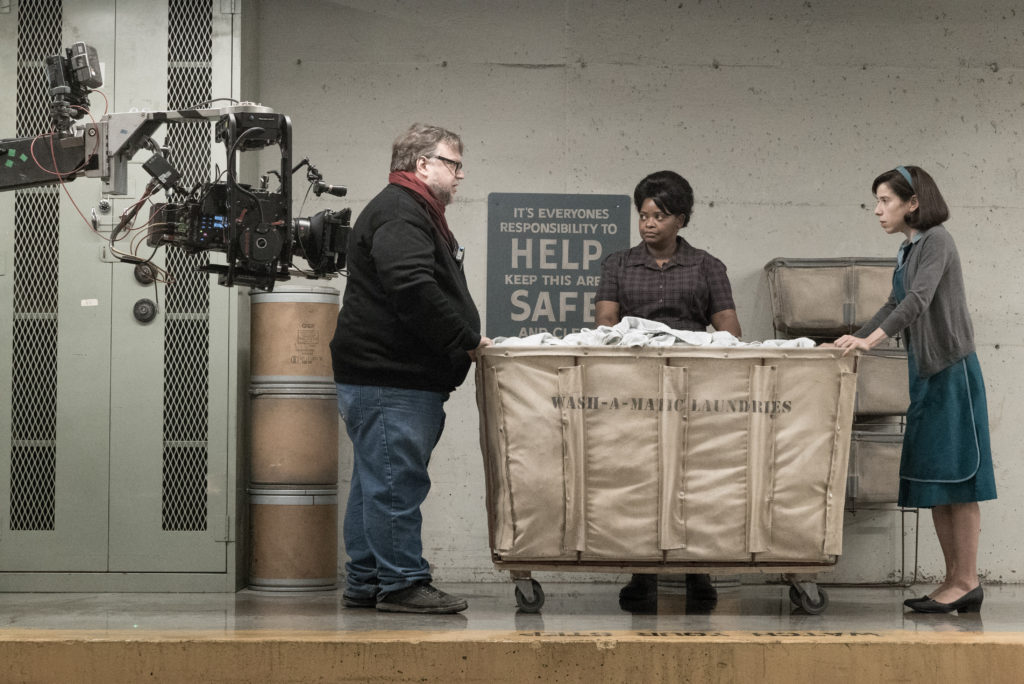A janitor at a government laboratory befriends an amphibian creature. If you pitched that idea to most directors, they likely would have thought it too strange. But most directors are not Guillermo del Toro. After all, strange is del Toro’s strong suit.
Del Toro is critically acclaimed for his eccentric films about mystical worlds and monsters, including the dark fantasy “Pan’s Labyrinth,” sci-fi monster flick “Pacific Rim” and gothic horror film “Crimson Peak.” The Mexican filmmaker’s latest project, “The Shape of Water,” is 46 years in the making. A six-year old del Toro, inspired by “Creature From the Black Lagoon,” pondered making a film that subverted the typical structure of government agents finding a mysterious creature in the Amazon. The idea wasn’t solidified until 2011, when he had breakfast with his co-author of “Trollhunters,” Daniel Kraus, who shared with him the concept that would evolve into “The Shape of Water.”
The film takes place in 1960s Baltimore, where the mute Elisa Esposito (Sally Hawkins) works as a janitor at a top-secret government laboratory. When she falls in love with an amphibious alien creature (Doug Jones) whom the government is using as a test subject, she must try to save him before he is killed by her boss, the evil Colonel Richard Strickland (Michael Shannon).
The Emory Wheel participated in a conference call with del Toro Nov. 19 to talk about the film’s plot, setting and characters. “The Shape of Water” was released in theaters Dec. 1.
This transcript has been edited for clarity and length.
Haley Bennett, The Minnesota Daily: You set “The Devil’s Backbone” and “Pan’s Labyrinth” at the beginning and end of the Spanish Civil War, respectively, but “The Shape of Water” takes place in the U.S. during the Cold War. What feels different to you about the culture of paranoia versus the culture of outright war?
Guillermo del Toro: I think movies that happen anywhere matter nowhere, and movies that happen anytime matter at no time. As a storyteller, you need to choose the place and time [films] take place very carefully and specifically. 1962 is, of course, the Cold War and the space race, but it’s [also] the last fairytale time in America, a time when America kind of dreams itself into what we conceive as the modern America.
[In 1962,] the media was shaping the consciousness and the identity of the country. [There was] a conflict that had yet to escalate and suburban wealth everywhere: cars in every garage, TVs, self-cleaning kitchens, petticoats and hairspray. It was a time of great hope for the future. In fact, the country became obsessed with the idea of the future. I thought that was a perfect setting to bring in a creature from the ancient past.
Also, the movie is about our problems today — about fearing and hating others — and how hate is more destructive than learning to love and understand. I thought if I made the film take place in the present day it would be too topical about news and social media. But if I say, “Once upon a time in 1962,” it becomes a fairy tale of troubled times. That way, people can lower their guard a little bit more and listen to the story and characters and talk about the issues rather than the circumstances of the issues.
William Konig, TCU 360: It’s unusual to have two of your main characters be incapable of communicating with each other in a conventional way. What was the influence behind having that decision?
GDT: I think that words can lie but looks cannot. I wanted to have characters that were able to communicate emotion and love to the audience through looks, touch, body language and essence — because it’s impossible to talk about love. You can sing about love but you cannot talk [about it].
Elisa and the creature have this [inability to speak] in common. They are not looked at as complete beings, but they are. [The two characters] are reduced to ideologies or ideas that are more reductive than their complexity. The creature is [viewed] by different people differently throughout the film. For the antagonist Strickland, [the creature] is a filthy thing that came from South America. For the Russian scientist [Robert] Hoffstetler (Michael Stuhlbarg), he’s seen as the magic of nature and science. For Elisa, she recognizes his essence.
Elisa is also viewed differently for the other characters. For Zelda (Octavia Spencer), she is a listener to her inner monologues. For Giles (Richard Jenkins), she’s almost like a daughter. For Strickland, she’s a woman that he wants to dominate, or that he thinks he controls because she’s under his employment. The [creature], this elemental god from the Amazon, is the only one that sees Elisa exactly as she is.
Ludwig Hurtado, UCLA Radio: Sally and the creature are both marginalized characters who communicate with a nonverbal language of love. Is that a running theme for you?
GDT: A lot of this movie talks about isolation and communication. That is in almost every character in the film. The antagonist Strickland wants to control and silence everyone and wants the world to conform to the way he sees it. [Elisa’s] neighbor, Giles, loves Elisa, but doesn’t quite understand her. Zelda has a problem communicating with her husband.
I wanted to show is that the characters who spoke communicate much less intently and purely than the characters that do not talk. That was certainly the intention in the movie.
The post King of the Creature Feature: Del Toro Discusses ‘The Shape of Water’ appeared first on The Emory Wheel.

